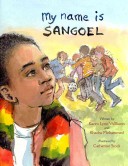 My Name is Sangoel
My Name is Sangoel
Written by Karen Lynn Williams & Khadra Mohammed
Illustrated by Catherine Stock
Eerdmans, 2009
ISBN: 9780802853073
Sangoel is an eight-year-old Sudanese refugee whose father has been killed in the war. When he leaves his natal country, the Wise One tells him, “You carry a Dinka name. It is the name of your father and your ancestors before him.” For Sangoel, a first-born son, his name carries his family history and connects him to his heritage.
Homeless in Sudan, Sangoel, his mother and sister are resettled in the United States. Upon arriving, Sangoel, as translator and the man in the family, takes the lead as the family learns to negotiate a fast-paced English-speaking, urban environment. In this new country where no one can pronounce Sangoel’s name correctly, the family must adjust to new customs and conveniences, such as a telephone and a TV. When he arrives at school, Sangoel is greeted by a teacher who mispronounces his name and classmates who tease him about his name or are too shy to practice it until they can say it in the Dinka way. The boy feels he has lost his identity. Even his mother suggests he might need an American name.
Sangoel clings to the significance of his name and is determined that others say it properly. He draws his name on a t-shirt using rebus symbols for “sun” and “goal,” as in a soccer goal. When his classmates finally pronounce his name correctly, Sangoel smiles; he feels respected. Then, his classmates follow his lead by creating rebus pictures of their own names. And when the teacher praises his good idea and his name, Sangoel announces just as the Wise Man told him, “My name is Sangoel. Even in America.”
This personal empowerment story is a continuation of a partnership between Karen Lynn Williams and Khadra Mohammed who co-authored Four Feet, Two Sandals (Eerdmans, 2007), which is reviewed in WOW Review, Volume 1, Issue 2. Khadra Mohommed, who is the director of the Pittsburgh Refugee Center, has worked with refugees in the U. S. and abroad for more than twenty years. Karen Lynn Williams served in the Peace Corps in Malawi; she currently volunteers at the Pittsburgh Refugee Center.
In their authors’ note for My Name is Sangoel, Williams and Mohammed suggest that keeping one’s name is a way for immigrants to remain connected to their heritage. They describe the plight of refugees, including those from Sudan like Sangoel. They also share the naming practices of the Dinka, a southern Sudanese tribe. Catherine Stock’s watercolor and collage illustrations depict the changing geography of the refugee experience from the refugee camp, to the bustle of the big city, and to a classroom where classmates from diverse backgrounds learn about the larger world through interacting with one another.
Readers, children and adults, can show respect for the richness of difference through honoring the significance of our names. Each year when school begins or a new student enters a classroom, children’s names become important markers for personal and cultural identification. With increasingly diverse school populations, educators and classmates alike are asked to open their hearts and increase their knowledge of others’ cultural heritages as represented in the meanings and significance that are part and parcel of our names.
A selected annotated bibliography of children’s picture books in which names matter:
I Call My Grandpa Papa by Ashley Wolff (Tricycle Press, 2009)
When the teacher brings Ye-Ye, her grandfather from China to meet her class, the children share what they call their grandfathers and what they enjoy doing with them through words and drawings. In I Call My Grandma Nana, the teacher introduces her grandmother to her multiethnic class and learns their names for their grandmothers.
My Name is Jorge On Both Sides of the River: Poems in English and in Spanish by Jane Medina, illustrated by Fabricio Vanden Broeck (Boyd’s Mills Press, 1999)
In this bilingual collection of poems, Jorge shares how the teacher’s decision to change his name to “George” affects a boy who is trying to find his place in a new culture without losing his first culture. Jorge struggles but manages to retain his dignity as he suffers teasing from his classmates, learns new school routines, and a new language. He retains his self-respect as he insists on being called “Jorge” on both sides of the river that separates Mexico and the United States.
The Name Jar by Yangsook Choi, illustrated by (Knopf, 2001)
When the teacher and students cannot pronounce Unhei’s name, the new girl is, at first, embarrassed to be different. She is happy when her classmates add name suggestions to a glass jar placed on her desk. But Unhei changes her mind after reading a letter from Korea from her grandmother and experiencing the friendship of a classmate who makes a special effort to learn her name. Unhei proudly presents herself to the class by writing her name in English and in Korean and tells her classmates her name means “Grace.”
Judi Moreillon, School of Library and Information Studies, Texas Woman’s University, Denton, Texas
WOW Review, Volume II, Issue 3 by Worlds of Words is licensed under a Creative Commons Attribution-NonCommercial-ShareAlike 4.0 International License. Based on work at https://wowlit.org/on-line-publications/review/ii-3/
